Download This Sample
This sample is exclusively for KidsKonnect members!
To download this worksheet, click the button below to signup for free (it only takes a minute) and you'll be brought right back to this page to start the download!
Sign Me Up
Table of Contents
The Zika virus, a flavivirus spread by mosquitoes, was initially discovered in Uganda in 1947 in monkeys. Later, in 1952, it was found in people in the United Republic of Tanzania and Uganda.
See the fact file below for more information on the Zika Virus or alternatively, you can download our 26-page Zika Virus worksheet pack to utilise within the classroom or home environment.
Key Facts & Information
HISTORY
- The Zika virus was initially discovered in a sentry monkey used to search for the yellow fever virus in the Ugandan Zika Forest in 1947. Since cell lines were not yet available for the study of viruses, mice were given intracerebral injections of febrile monkey serum.
- The virus discovered in the mice’s brains made them sick and was named Zika virus. Subsequently, the same virus was found in Aedes africanus mosquitoes in the Zika forest.
- Humans had antibodies against the Zika virus, according to 1950s serological investigations, and the virus was first identified in people in Nigeria in 1968.
- Other African nations, including Uganda, Tanzania, Egypt, the Central African Republic, Sierra Leone, and Gabon, as well as Asia, have infection evidence, according to later serological research (India, Malaysia, Philippines, Thailand, Vietnam, and Indonesia).
- Due to outbreaks on Yap Island and in French Polynesia in 2007 and 2013, the Zika virus spread outside of Africa and Asia.
- Brazil reported the first cases in the Americas in May 2015. The virus in Brazil is of Asian genotype and may have been brought there during the 2014 World Cup. The Zika virus has now reached 23 nations in the Americas as of this writing.
VIROLOGY
- The Zika virus, yellow fever virus, dengue virus, Japanese encephalitis virus, and West Nile virus are all members of the mosquito-borne flavivirus family. A capsid and membrane envelop the 10.8 kilobases of positive-strand RNA that makes up the genome.
- The membrane-embedded envelope (E) glycoprotein enables viral particle attachment to the host cell receptor to start an infection. Like other flaviviruses, antibodies to the E glycoprotein are crucial for preventing disease.
TRANSMISSION
- Humans contract the Zika virus from mosquito bites. Aedes africanus, Ae. apicoargenteus, Ae. leuteocephalus, Ae. aegypti, Ae. vittatus, and Ae. furcifer are only a few of the Aedes genus mosquitoes that have been linked to the virus. In the 2007 Zika virus outbreak in Gabon, Ae. albopictus was found to be the primary vector of the disease.
- It is unknown whether there are non-human reservoirs for the Zika virus.
- News stories in 2015 brought attention to the Zika virus’ quick spread throughout Latin America and the Caribbean. At the time, the Pan American Health Organization provided a list of nations and territories where “local Zika virus transmission” occurred.
- The female Ae. aegypti mosquito, mainly active during the day, is the primary vector of Zika. To lay their eggs, mosquitoes need to consume blood.
- Additionally, the virus has been found in some Aedes species of arboreal mosquitoes, including Ae. Africanus, Ae. apicoargenteus, Ae. furcifer, Ae. hensilli, Ae. luciocephalus as well as Ae. vittatus, which has an extrinsic incubation time of roughly ten days in mosquitoes.
- The vectors’ actual range still needs to be solved. Several Aedes species, including Anopheles coustani, Mansonia uniformis, and Culex perfuscus, have been discovered to carry the Zika virus, though this does not imply that they are the disease’s vectors.
- The geographic range of the mosquito species that spread Zika can be used to define the possible societal danger. The prevalence of the most prominent Zika carrier, Ae. aegypti is growing as a result of international trade and travel.
- Zika may be more susceptible to variations in precipitation and temperature than dengue, making it more likely to be restricted to tropical regions, according to research into its biological niche.
- However, when global temperatures rise, the disease vector’s range will be able to extend further north, allowing Zika to follow.
SIGNS AND SYMPTOMS
- The majority of Zika virus victims exhibit minimal or no symptoms. 2–10 days after contracting the virus, about 25% of infected individuals experience rash, fever, joint discomfort, red eyes, and headaches. In most cases, recovery is complete, and fatalities are uncommon.
- Infection with the Zika virus has been linked to congenital microcephaly in Brazil. Although there are other reasons for microcephaly, the number of cases has increased because of the Zika virus outbreak in that nation.
- It is unknown if this birth abnormality is brought on by Zika virus infection.
- Studies observing pregnant women to see if Zika virus infection results in microcephaly are required.
- The outbreak has become more hazardous due to two Zika virus-related diseases. The first is the onset of Guillain-Barré syndrome, characterized by increasing muscle weakness brought on by peripheral nervous system injury. The Guillain-Barré virus was initially linked to an epidemic in 2013 in French Polynesia.
ZIKA VIRUS VACCINE
- Vaccination against the Zika virus is intended to stop the signs and effects of human infection with the virus. As the Zika virus can infect pregnant women and cause congenital disabilities in the fetus, the vaccine aims to protect against congenital Zika syndrome during the current outbreak or any upcoming ones.
- Various vaccines are presently undergoing clinical testing, but as of April 2019, none have received approval for patient use. A Zika virus vaccine aims to create particular antibodies against the virus to fend off infection and severe illness.
- Limiting side effects like those of Guillain-Barré syndrome, a possible result of Zika virus infection, is one of the obstacles in creating a safe and effective vaccine.
- Additionally, the vaccination must reduce the likelihood of antibody-dependent intensification of dengue virus infection because the dengue virus and the Zika virus share many similarities.
Zika Virus Worksheets
This fantastic bundle includes everything you need to know about the Zika Virus across 25 in-depth pages. These are ready-to-use worksheets about the Zika Virus, a flavivirus spread by mosquitoes, which was initially discovered in Uganda in 1947 in monkeys.
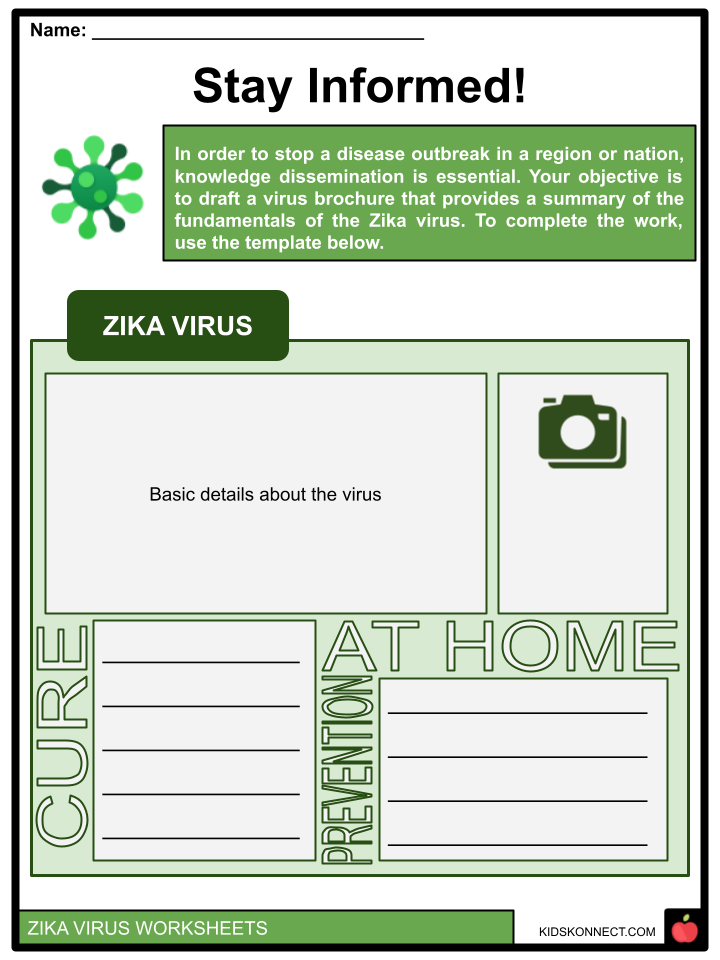

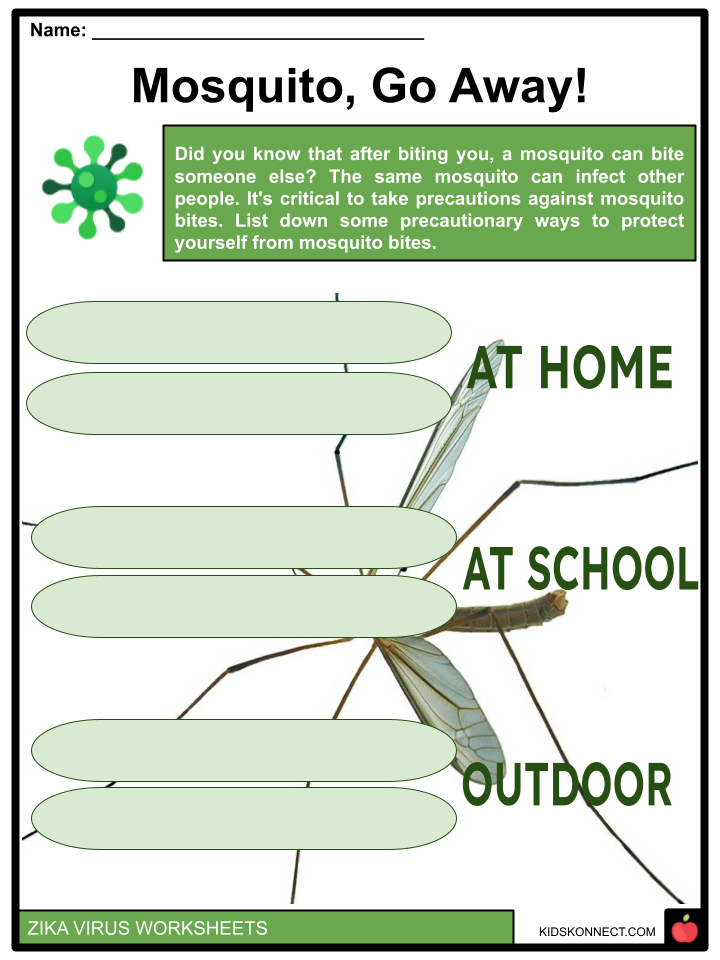
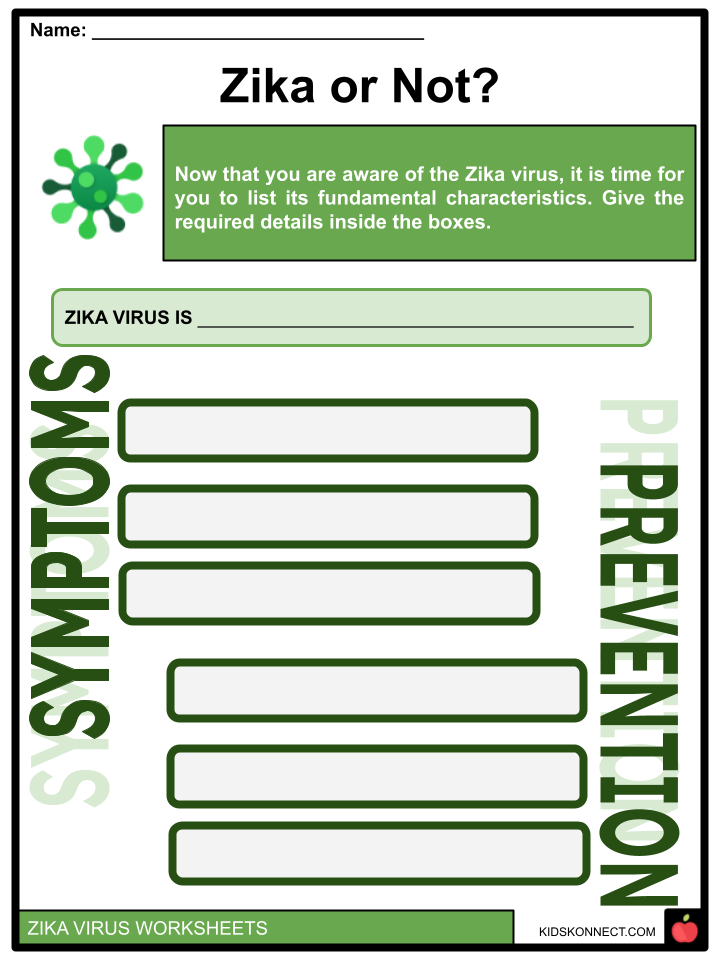
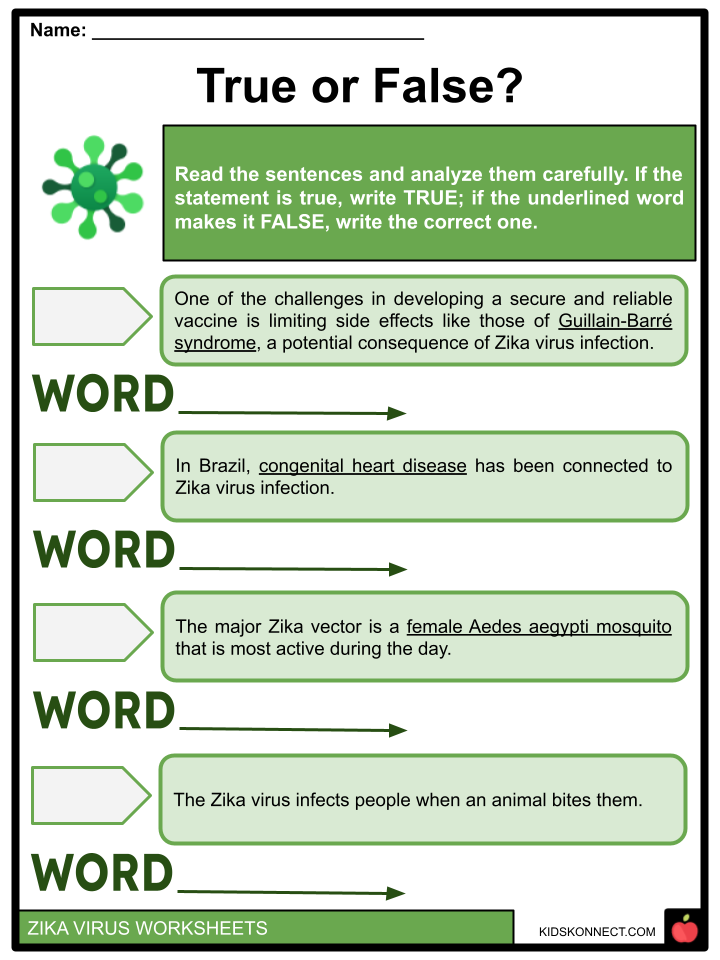
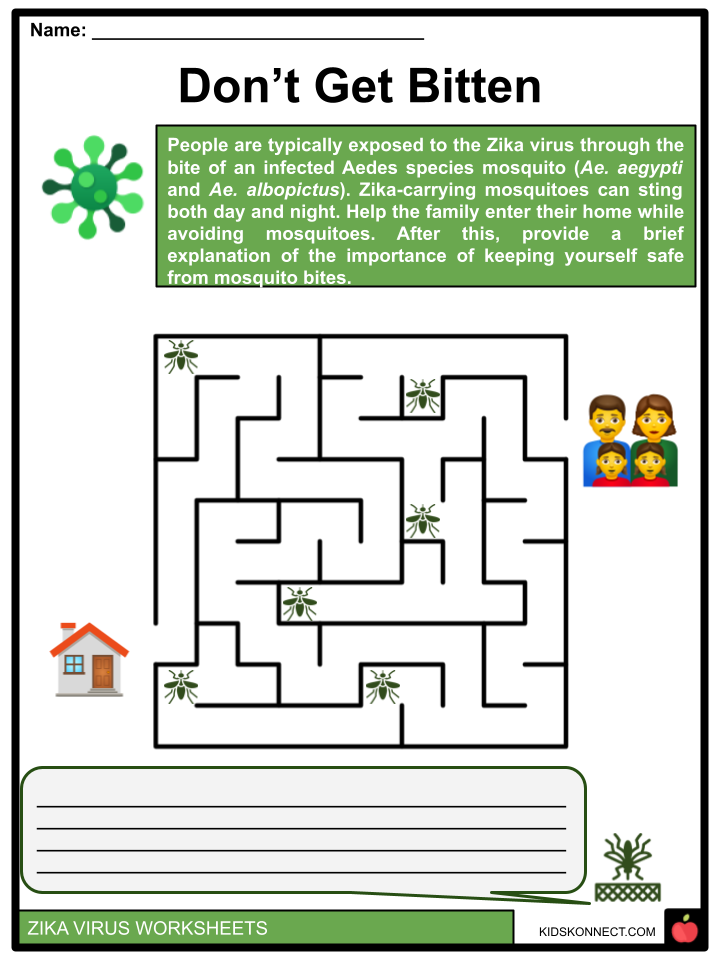
Complete List Of Included Worksheets
- Zika Virus Facts
- True or False?
- Illustrate that Word
- Zika or Not?
- Don’t Get Bitten
- Virus in Your Body
- Mosquito, Go Away!
- What Will I Do?
- Stay Informed!
- Keep Safe!
- Zika Spotlight
Link/cite this page
If you reference any of the content on this page on your own website, please use the code below to cite this page as the original source.
Link will appear as Zika Virus Facts & Worksheets: https://kidskonnect.com - KidsKonnect, December 8, 2022
Use With Any Curriculum
These worksheets have been specifically designed for use with any international curriculum. You can use these worksheets as-is, or edit them using Google Slides to make them more specific to your own student ability levels and curriculum standards.



